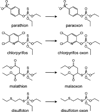Novel approaches to mitigating parathion toxicity: targeting cytochrome P450-mediated metabolism with menadione
- PMID: 27441453
- PMCID: PMC5220671
- DOI: 10.1111/nyas.13156
Novel approaches to mitigating parathion toxicity: targeting cytochrome P450-mediated metabolism with menadione
Abstract
Accidental or intentional exposures to parathion, an organophosphorus (OP) pesticide, can cause severe poisoning in humans. Parathion toxicity is dependent on its metabolism by the cytochrome P450 (CYP) system to paraoxon (diethyl 4-nitrophenyl phosphate), a highly poisonous nerve agent and potent inhibitor of acetylcholinesterase. We have been investigating inhibitors of CYP-mediated bioactivation of OPs as a method of preventing or reversing progressive parathion toxicity. It is well recognized that NADPH-cytochrome P450 reductase, an enzyme required for the transfer of electrons to CYPs, mediates chemical redox cycling. In this process, the enzyme diverts electrons from CYPs to support chemical redox cycling, which results in inhibition of CYP-mediated biotransformation. Using menadione as the redox-cycling chemical, we discovered that this enzymatic reaction blocks metabolic activation of parathion in rat and human liver microsomes and in recombinant CYPs important to parathion metabolism, including CYP1A2, CYP2B6, and CYP3A4. Administration of menadione to rats reduces metabolism of parathion, as well as parathion-induced inhibition of brain cholinesterase activity. This resulted in inhibition of parathion neurotoxicity. Menadione has relatively low toxicity and is approved by the Food and Drug Administration for other indications. Its ability to block parathion metabolism makes it an attractive therapeutic candidate to mitigate parathion-induced neurotoxicity.
Keywords: menadione; organophosphorus pesticides; paraoxon; parathion; redox cycling.
© 2016 New York Academy of Sciences.
Conflict of interest statement
The authors declare no conflicts of interest.
Figures




References
-
- Marrs TC. Organophosphate poisoning. Pharmacol. Ther. 1993;58:51–66. - PubMed
-
- King AM, Aaron CK. Organophosphate and carbamate poisoning. Emerg. Med. Clin. North Am. 2015;33:133–151. - PubMed
-
- Jett DA, Richardson JR. Neurotoxic Pesticides. In: Dobbs MR, editor. Clinical Neurotoxicology: Syndromes, Substances, and Environments. San Diego, CA: Elsevier; 2009. pp. 491–499.
-
- Lotti M. Treatment of acute organophosphate poisoning. Med. J. Aust. 1991;154:51–55. - PubMed
-
- Kuca K, Juna D, Musilek K. Structural requirements of acetylcholinesterase reactivators. Mini Rev. Med. Chem. 2006;6:269–277. - PubMed
Publication types
MeSH terms
Substances
Grants and funding
LinkOut - more resources
Full Text Sources
Other Literature Sources
Miscellaneous

